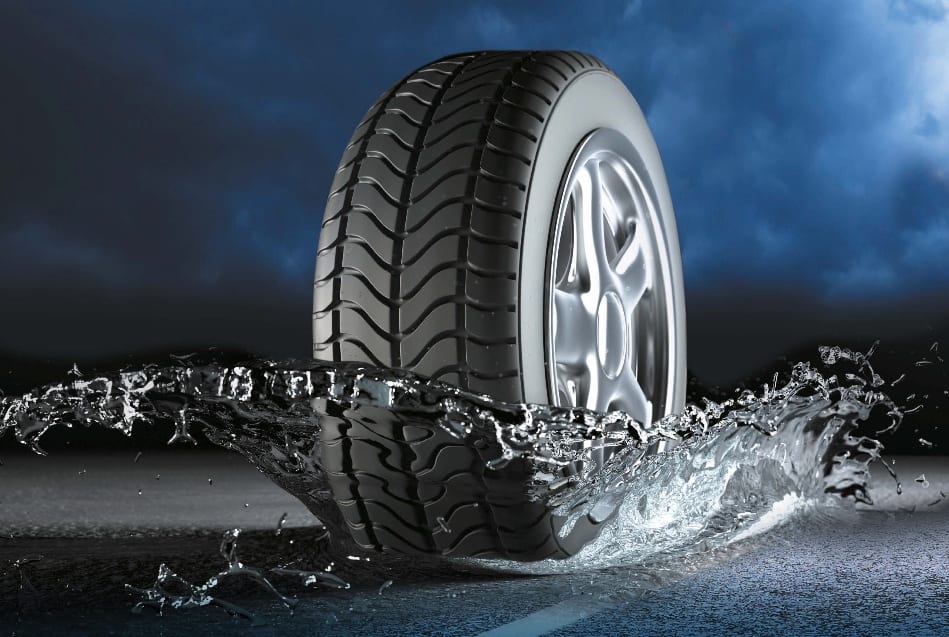[vc_row full_width=”stretch_row” css=”.vc_custom_1599828000020{background-color: #f1f1f1 !important;}”][vc_column width=”1/2″]
How to Check Your Tyre Tread Depth
Driving in the rain with worn tyres can heighten your risk of accidents. Braking distances and the risk of aquaplaning increase significantly under these conditions.
In this guide, we’ll show you how to check tyre tread and explain why it’s important. We’ll also cover the legal tread depth; the minimum tread depth recommended by experts and answer your frequently asked questions.[/vc_column_text][/vc_column][vc_column width=”1/2″][vc_video link=”https://youtu.be/1qrzev9V4MY”][/vc_column][/vc_row][vc_row full_width=”stretch_row” css=”.vc_custom_1596124875841{border-top-width: 1px !important;border-bottom-width: 1px !important;padding-top: 40px !important;padding-bottom: 40px !important;border-top-color: #ededed !important;border-top-style: solid !important;border-bottom-color: #ededed !important;border-bottom-style: solid !important;border-radius: 1px !important;}”][vc_column width=”1/2″]
What does “tread depth” mean & why is it important?
It is made up of ribs, grooves, blocks and sipes which work to improve the tyre’s performance.
Patterns and performance goals vary among manufacturers. But the primary function of the tread is to keep the tyre in contact with the road in wet weather by effectively displacing water.
The deeper the tyre tread, the more water it can clear from the road surface and the better its grip. As a tyre’s tread pattern wears down or as the depth of water increases, less grip is provided.
Drivers should take this into consideration and reduce their speed accordingly in wet conditions.
It is important to regularly check the tread depth of your tyres to ensure that they’re well above the legal minimum.
Driving with tyres below this limit is not only a safety hazard but also puts you at risk of incurring a fine of £2,500 and three penalty points PER tyre. Ideally, you should check your tyres every month.[/vc_column_text][/vc_column][vc_column width=”1/2″][vc_video link=”https://www.youtube.com/watch?v=Q1PMh-8x6sk&”]
Legal tyre tread depth limit in the UK
The legal tread depth minimum for motorcycles, large vehicles and passenger-carrying vehicles in the UK is 1mm.
Your tyre should meet the legal minimum tread depth across three quarters of the centre of the tyre around its complete circumference.[/vc_column_text][/vc_column][/vc_row][vc_row full_width=”stretch_row” css=”.vc_custom_1728463446504{border-top-width: 1px !important;border-bottom-width: 1px !important;padding-top: 40px !important;padding-bottom: 40px !important;background-color: #EEEEEE !important;border-top-style: solid !important;border-bottom-style: solid !important;border-radius: 1px !important;border-color: #ededed !important;}”][vc_column width=”1/2″]
Minimum tread depth in the UK
Waiting until the last minute to replace your tyre can prove risky as a significant amount of tread can be worn in just one emergency manoeuvre.
Did you know that the difference between illegal and borderline is just 0.4mm – that’s half the thickness of a bank card!
Without adequate tyre tread depth, your tyres may not be able to perform properly in wet conditions, reducing your safety on the road. In wet weather, tyre tread grooves help to remove water from the contact patch between your tyres and the road surface meaning your car can brake, steer and accelerate properly. Failing to have the legal depth of tyre tread for a car or other vehicle puts you at a huge risk of accidents. In tests carried out by MIRA, the difference in wet braking distances for cars with 3mm of tyre tread and 1.6mm of tyre tread increased by up to 44%. It is therefore advisable to consider replacing your tyres well before they reach the legal tyre tread limit.[/vc_column_text][/vc_column][vc_column width=”1/2″][vc_single_image image=”20722″ img_size=”full” css=””][/vc_column][/vc_row][vc_row full_width=”stretch_row” css=”.vc_custom_1728464932799{padding-top: 40px !important;padding-bottom: 40px !important;background-color: #FFFFFF !important;border-color: #FFFFFF !important;}”][vc_column width=”1/2″][vc_video link=”https://www.youtube.com/watch?v=Q1PMh-8x6sk&”][/vc_column][vc_column width=”1/2″]
Tread depth and aquaplaning
Aquaplaning occurs when the water cannot be removed from between the tyre and the road. This causes the vehicle to lose all contact with the road, which effectively leaves the vehicle out of control. The risk of aquaplaning increases as a tyre’s tread depth is reduced as there is insufficient tread to clear the water properly from the road surface.
Lack of contact with the road means you are unable to accelerate or steer effectively, greatly increasing your risk of being involved in an accident.
It is also unsafe to try to brake when aquaplaning as contact with the road may be regained in an unpredictable manner, causing the vehicle to spin uncontrollably.
To reduce your risk of aquaplaning, it’s important to check your tyre tread and tyre pressure regularly.[/vc_column_text][/vc_column][/vc_row][vc_row full_width=”stretch_row” css=”.vc_custom_1596124875841{border-top-width: 1px !important;border-bottom-width: 1px !important;padding-top: 40px !important;padding-bottom: 40px !important;border-top-color: #ededed !important;border-top-style: solid !important;border-bottom-color: #ededed !important;border-bottom-style: solid !important;border-radius: 1px !important;}”][vc_column]
Tyre tread FAQs
If you can’t see the coin’s outer band, your tyres are above the legal limit.
You can also use a tyre tread gauge, which is designed to measure individual tyre grooves.[/vc_toggle][vc_toggle title=”How do wet conditions or roads affect tyre grip?” custom_font_container=”tag:h3|text_align:left” custom_use_theme_fonts=”yes” css=”” use_custom_heading=”true”]Tyre treads are designed to give good grip on wet roads but in general wet grip decreases as the tyre tread depth approaches the legal minimum.
Motorists should take this into consideration and reduce speed when driving in wet conditions.
For the same reason, motorists may wish to consider replacing tyres before reaching the tyre tread limit.[/vc_toggle][vc_toggle title=”What is the tread depth of a new tyre?” custom_font_container=”tag:h3|text_align:left” custom_use_theme_fonts=”yes” use_custom_heading=”true”]New tyres have a tread depth of between 8-9 mm.[/vc_toggle][vc_toggle title=”How long will 3mm tyre tread last?” custom_font_container=”tag:h3|text_align:left” custom_use_theme_fonts=”yes” css=”” use_custom_heading=”true”]Generally, tyres with 3mm of tread depth will last between 10,000 and 20,000 miles taking into account different road conditions. However, it is recommended that tyres with 3mm tread depth are replaced as quickly as possible.[/vc_toggle][vc_toggle title=”How long will 2mm tyre tread last?” custom_font_container=”tag:h3|text_align:left” custom_use_theme_fonts=”yes” css=”” use_custom_heading=”true”]It is recommended that you change your tyre before it reaches this point but tyres with 2mm of tread depth can expect to last ~1000 miles depending on the driving conditions.[/vc_toggle][vc_toggle title=”Aquaplaning vs hydroplaning – what’s the difference?” custom_font_container=”tag:h3|text_align:left” custom_use_theme_fonts=”yes” css=”” use_custom_heading=”true”]There isn’t one! Both aquaplaning and hydroplaning refer to what happens when water builds up in front of your tyres and prevents them from making contact with the road. These terms are just synonyms of the same phenomenon.[/vc_toggle][vc_toggle title=”Do winter tyres have a bigger tread?” custom_font_container=”tag:h3|text_align:left” custom_use_theme_fonts=”yes” css=”” use_custom_heading=”true”]Many winter tyres come with a deeper tread depth when new. Designed with specialised tread patterns and compounds, winter tyres are the safest option from October to March, when temperatures drop, and conditions become challenging. The minimum tread depth recommended for winter tyres is 4mm.[/vc_toggle][/vc_column][/vc_row][vc_row][vc_column]

